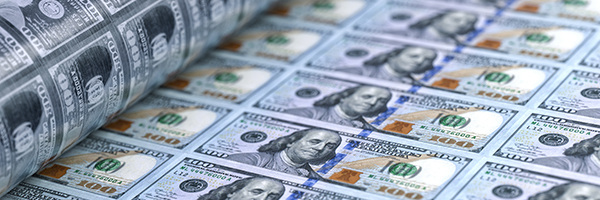Short Term

May 9, 2022 | Daily JAM, Short Term |
Today, the Start & Poor’s 500 closed at 3991.24. That’s below the magic 4,000 level. For weeks investors and traders, technically inclined of not, have focused on 4,000 for the Standard & Poor’s 500.

May 2, 2022 | Daily JAM, Morning Briefing, Short Term |
Economists surveyed by Bloomberg project the Federal Reserve will hike its benchmark short-term interest rate by 50 basis points on Wednesday in an effort to damp inflation. And bond traders have just decided that the U.S.central bank will raise rates by 75 basis points at its June 15 meeting. The CME Fed Watch Tool, which uses prices in the Fed Funds Futures market to calculate odds of a fed move, puts the odds of a 50 basis point increase from the current 0.25% to 0.50% to 0.50 to 0.75% at 99.8%. That tool puts the odds of a 75 basis point increase air the June 15 meeting at 87%. That’s up from odds for just 18% on April 1. Bond prices are down and bond yields are up today.

April 28, 2022 | Daily JAM, Short Term |
The U.S. economy unexpectedly shrank at a 1.4% annualized rate in the first quarter of 2022, the Bureau of Economic Analysis reported Thursday, April 28. The first quarter results follow on a 6.9% rate in the fourth quarter. Economists had projected a 1% tate of growth for the quarter. But since Wall Street was already expecting a big slowdown in growth for the quarter and because a peek below the headline numbers argued that the lower growth rate would be temporary, stocks surged on Thursday.

April 27, 2022 | Daily JAM, Short Term |
China’s President Xi Jinping has vowed to boost China’s economy, struggling under the impact of widespread Covid-19 lockdowns and a collapse in the property development sector, by pushing more infrastructure spending into the economy. This has been China’s tried and true first response to faltering growth. But this time it seems unlikely to work.

April 26, 2022 | Daily JAM, Morning Briefing, Short Term |
China expanded coronavirus testing to most of Beijing as rising cases fuel fears about an unprecedented lockdown of the capital. Officials on Monday night said testing would take place in another 11 of Beijing’s 16 districts, moving beyond just Chaoyang, where most of the infections have been detected since Friday. The city of more than 20 million people has already locked down parts of the eastern district of Chaoyang, home to 3.5 million people, with plans to ease restrictions after residents complete a testing regimen on April 27. The bad news from Beijing added to new bad news from a locked down Shanghai

April 17, 2022 | Daily JAM, Morning Briefing, Short Term |
U.S. benchmark West Texas Intermediate crude for May delivery climbed 1% to $108.01 a barrel at 10:09 a.m. Monday in Singapore. International benchmark Brent crude for June delivery gained 1.1% to $112.97 a barrel on the ICE Futures Europe exchange. Two Libyan ports have been forced to stop loading oil

April 11, 2022 | Daily JAM, Short Term, You Might Have Missed |
Economists surveyed by Reuters are projecting that inflation, as measured by the Consumer Price Index (CPI), will climb to 8.4% year over year for March against an 8% rate in February when data is released tomorrow before the open of the U.S. stock market.

April 9, 2022 | C, Daily JAM, Dividend Income, Jubak Picks, KBWB, Perfect Five-ETFs, Short Term, USB, WFC, You Might Have Missed |
Big banks will kick off another earnings season beginning with JPMorgan Chase (JPM) on Wednesday, April 13. Citigroup (C) and Wells Fargo (WFC) follow on April 14. Bank of America (BAC) reports on April 18. Bank earnings forecasts present a complicated picture for the quarter–which is only appropriate since that’s true of Standard & Poor’s 500 earnings forecasts as a whole.

April 6, 2022 | Daily JAM, Short Term |
Minutes from the March meeting of the Federal Reserve released Wednesday, April 6, showed that only Russia’s invasion of Ukraine kept the central bank from raising benchmark interest rates by 50 basis points instead the 25 basis-point increase the Fed actually instituted at that meeting. “Many” Fed officials viewed one or more half-point increases as appropriate going forward if price pressures fail to moderate. The minutes showed the Fed proposing to shrink its balance sheet at a maximum pace of $60 billion in Treasuries and $35 billion in mortgage-backed securities each month. That’s in line with market expectations

April 5, 2022 | Daily JAM, Morning Briefing, Short Term, You Might Have Missed |
In remarks prepared for a Tuesday speech to the Minneapolis Federal Reserve Bank Federal Reserve Governor Lael Brainard said “Currently, inflation is much too high and is subject to upside risks. The committee is prepared to take stronger action if indicators of inflation and inflation expectations indicate that such action is warranted.” And she called for reducing the Fed’s balance sheet as early as next month. The bond market certainly heard Brainard’s remarks as a promise of more action faster.

March 31, 2022 | Daily JAM, Morning Briefing, Short Term |
Today, March 31, OPEC+, which includes Russia, decided to stick with their previously agreed plan of modest monthly increases. Despite repeated asks from Washington and European countries to increase production in order to make up for shortfalls from Russia due to Western sanctions on that country as a result of its invasion of Ukraine, OPEC+ said it would increase oil output in May by 432,000 barrels a day, a slight uptick from the agreed increase of 400,000 barrels a day. The small increase–essentially no increase at all–would be for “technical reasons.” OPEC+ repeated its outlook for a month ago saying that the outlook was for “a well-balanced market” and that recent volatility in prices was “not caused by fundamentals, but by ongoing geopolitical developments.” Well, yeah. And isn’t that the point?

March 30, 2022 | Daily JAM, Morning Briefing, Short Term |
Hopes for a cease fire in Ukraine and for serious peace talks between Russia and Ukraine took the stock indexes up yesterday and the price of oil and oil stocks down. News of renewed Russian shelling today took the market back down and oil and oil stocks back up today.













